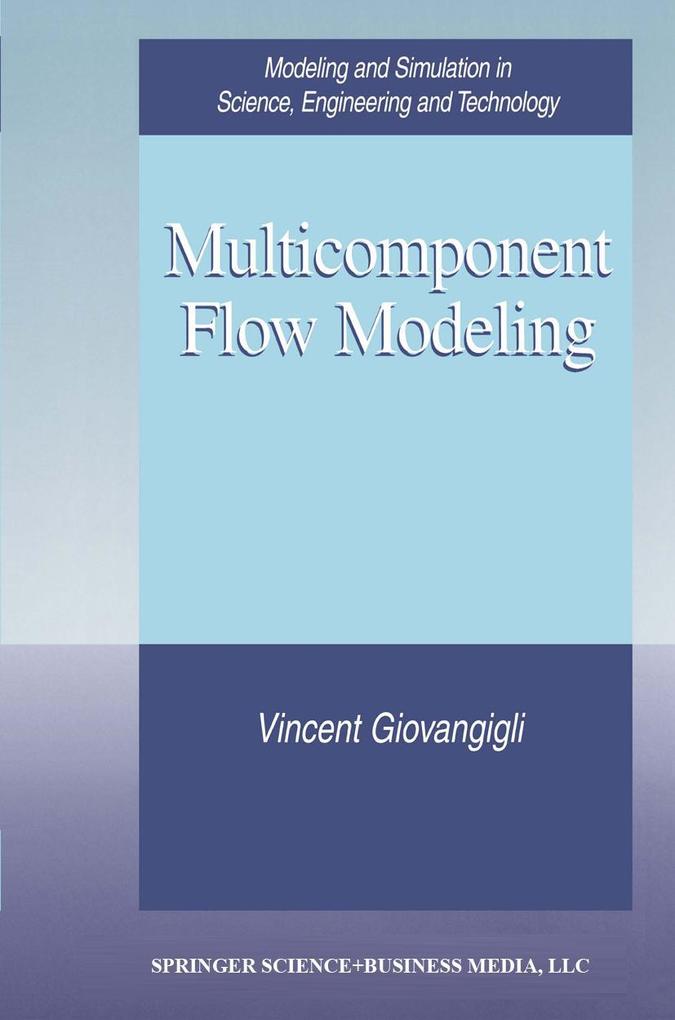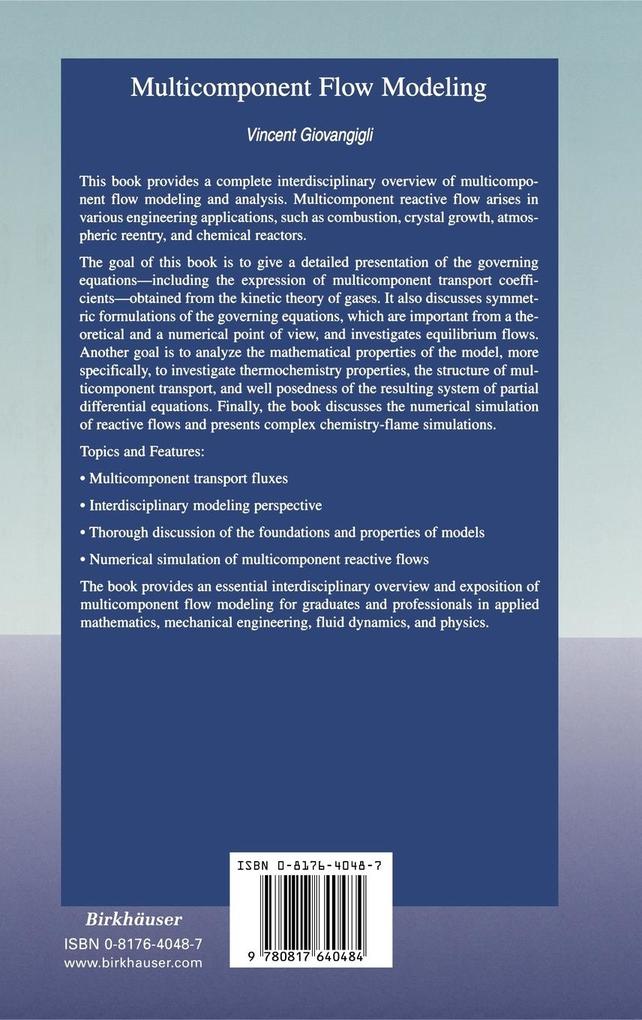The goal of this is book to give a detailed presentation of multicomponent flow models and to investigate the mathematical structure and properties of the resulting system of partial differential equations. These developments are also illustrated by simulating numerically a typical laminar flame. Our aim in the chapters is to treat the general situation of multicomponent flows, taking into account complex chemistry and detailed transport phe nomena. In this book, we have adopted an interdisciplinary approach that en compasses a physical, mathematical, and numerical point of view. In par ticular, the links between molecular models, macroscopic models, mathe matical structure, and mathematical properties are emphasized. We also often mention flame models since combustion is an excellent prototype of multicomponent flow. This book still does not pretend to be a complete survey of existing models and related mathematical results. In particular, many subjects like multi phase-flows , turbulence modeling, specific applications, porous me dia, biological models, or magneto-hydrodynamics are not covered. We rather emphasize the fundamental modeling of multicomponent gaseous flows and the qualitative properties of the resulting systems of partial dif ferential equations. Part of this book was taught at the post-graduate level at the Uni versity of Paris, the University of Versailles, and at Ecole Poly technique in 1998-1999 to students of applied mathematics.
Inhaltsverzeichnis
1. Introduction. - 2. Fundamental Equations. - 2. 1. Introduction. - 2. 2. Conservation equations. - 2. 3. Thermodynamics. - 2. 4. Chemistry. - 2. 5. Transport fluxes. - 2. 6. Entropy. - 2. 7. Boundary conditions. - 2. 8. Notes. - 2. 9. References. - 3. Approximate and Simplified Models. - 3. 1. Introduction. - 3. 2. One-reaction chemistry. - 3. 3. Small Mach number flows. - 3. 4. Coupling. - 3. 5. Notes. - 3. 6. References. - 4. Derivation from the Kinetic Theory. - 4. 1. Introduction. - 4. 2. Kinetic framework. - 4. 3. Kinetic entropy. - 4. 4. Enskog expansion. - 4. 5. Zero-order approximation. - 4. 6. First-order approximation. - 4. 7. Transport linear systems. - 4. 8. Notes. - 4. 9. References. - 5. Transport Coefficients. - 5. 1. Introduction. - 5. 2. Transport algorithms. - 5. 3. Molecular parameters. - 5. 4. Shear viscosity. - 5. 5. Volume viscosity. - 5. 6. Diffusion matrix. - 5. 7. Thermal conductivity. - 5. 8. Thermal diffusion ratios. - 5. 9. Partial thermal conductivity. - 5. 10. Thermal diffusion coefficients. - 5. 11. Notes. - 5. 12. References. - 6. Mathematics of Thermochemistry. - 6. 1. Introduction. - 6. 2. Thermodynamics with volume densities. - 6. 3. Thermodynamics with mass densities. - 6. 4. Chemistry sources. - 6. 5. Positive equilibrium points. - 6. 6. Boundary equilibrium points. - 6. 7. Inequalities near equilibrium. - 6. 8. A global stability inequality. - 6. 9. Notes. - 6. 10. References. - 7. Mathematics of Transport Coefficients. - 7. 1. Introduction. - 7. 2. Assumptions on transport coefficients. - 7. 3. Properties of diffusion matrices. - 7. 4. Properties of other coefficients. - 7. 5. Diagonal diffusion. - 7. 6. Diffusion inequalities. - 7. 7. Stefan-Maxwell equations. - 7. 8. Notes. - 7. 9. References. - 8. Symmetrization. - 8. 1. Introduction. - 8. 2. Vector notation. - 8. 3. Quasilinear form. - 8. 4. Symmetrization and entropic variables. - 8. 5. Normal forms. - 8. 6. Symmetrization for multicomponent flows. - 8. 7. Normal forms for multicomponent flows. - 8. 8. Notes. - 8. 9. References. - 9. Asymptotic Stability. - 9. 1. Introduction. - 9. 2. Governing equations. - 9. 3. Local dissipative structure. - 9. 4. Global existence theorem. - 9. 5. Decay estimates. - 9. 6. Local dissipativity for multicomponent flows. - 9. 7. Global existence for multicomponent flows. - 9. 8. Notes. - 9. 9. References. - 10. Chemical Equilibrium Flows. - 10. 1. Introduction. - 10. 2. Governing equations. - 10. 3. Entropy and symmetrization. - 10. 4. Normal forms. - 10. 5. Global existence. - 10. 6. Notes. - 10. 7. References. - 11. Anchored Waves. - 11. 1. Introduction. - 11. 2. Governing equations. - 11. 3. First properties. - 11. 4. Existence on a bounded domain. - 11. 5. Existence of solutions. - 11. 6. Notes. - 11. 7. References. - 12. Numerical Simulations. - 12. 1. Introduction. - 12. 2. Laminar flame model. - 12. 3. Computational considerations. - 12. 4. Hydrogen-Air Bunsen flame. - 12. 5. References.



































